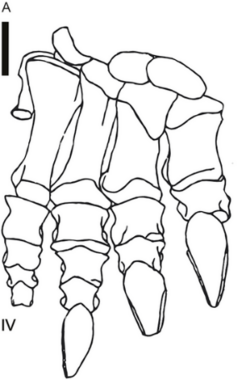Biology:Blikanasaurus
| Blikanasaurus | |
|---|---|

| |
| Pes from the holotype of B. cromptoni | |
| Scientific classification | |
| Domain: | Eukaryota |
| Kingdom: | Animalia |
| Phylum: | Chordata |
| Clade: | Dinosauria |
| Clade: | Saurischia |
| Clade: | †Sauropodomorpha |
| Clade: | †Sauropoda |
| Family: | †Blikanasauridae Galton & van Heerden, 1985 |
| Genus: | †Blikanasaurus Galton & van Heerden, 1985 |
| Species: | †B. cromptoni
|
| Binomial name | |
| †Blikanasaurus cromptoni Galton & van Heerden, 1985
| |
Blikanasaurus is a genus of sauropodomorph dinosaur from the late Triassic of South Africa . The generic name Blikanasaurus is derived from Greek, meaning "lizard from Blikana". The species name cromptoni is taken from the surname of A.W. “Fuzz” Crompton, an American paleontologist who led numerous field expeditions in Elliot Formation outcrop localities in South Africa . Blikanasaurus is only known from partial hindlimb bones that were recovered from the lower Elliot Formation (LEF) in the Eastern Cape.[1]
History of discovery
Blikanasaurus was first discovered by a partial hindlimb (epipodium and pes) found in the lower Elliot Formation (LEF) at the foot of Blikana mountain in Herschel, Eastern Cape of South Africa in c. 1965.[2][3] In the early 2000s, a second specimen - consisting of only a right metatarsal - was recovered from lower Elliot Formation deposits on the farm, Damplaats, in Ladybrand of the eastern Free State.[4][5][6] A possible ilium that has been attributed to Blikanasaurus was found recently, although its attribution to Blikanasaurus remains to be confirmed.
Description
As the two known Blikanasaurus specimens are extremely incomplete, very little is understood of this sauropodomorph taxon. The only information that has been deduced is from the bones of its hindlimb anatomy, which are heavily built. This suggests that Blikanasaurus was thickly set and robust.[7][8][9]
Classification
Due to its robust build, Blikanasaurus is hypothesized to have been an obligate quadruped[citation needed], unlike what is characteristic of more basal sauropodomorphs. Due to this feature, Blikanasaurus was thought initially to be a basal sauropod. Blikanasaurus is now considered to be a basal sauropodomorph[citation needed]; however, due to the lack of complete specimens, little remains known about this enigmatic taxon.[10] Some paleontologists claimed a case to group Blikanasaurus within the family Blikanasauridae, a family named by Galton and van Heerden in 1985,[11] however, this family has not been formally accepted due to it lacking definitive taxa. The cladogram below displays the currently accepted systematics between Blikanasaurus and other sauropodomorphs.[12]
| Sauropodiformes |
| ||||||||||||||||||||||||||||||||||||||||||||||||||||||||||||||||||||||||
References
- ↑ Knoll, Fabien (2004). "Review of the tetrapod fauna of the 'Lower Stormberg Group' of the main Karoo Basin (southern Africa) : Implication for the age of the Lower Elliot Formation". Bulletin de la Société Géologique de France 175: 73–83. doi:10.2113/175.1.73.
- ↑ Charig, A. J.; Attridge, J.; Crompton, A. W. (1965). "On the origin of the sauropods and the classification of the Saurischia". Proceedings of the Linnean Society of London 176 (2): 197–221. doi:10.1111/j.1095-8312.1965.tb00944.x.
- ↑ Galton, Peter M.; Van Heerden, Jacques (1985). "Partial hindlimb of Blikanasaurus cromptoni n. gen. And n. Sp.,representing a new family of prosauropod dinosaurs from the upper triassic of South Africa". Geobios 18 (4): 509–516. doi:10.1016/S0016-6995(85)80003-6.
- ↑ Yates, Adam M.; Kitching, James W. (2003). "The earliest known sauropod dinosaur and the first steps towards sauropod locomotion". Proceedings of the Royal Society of London. Series B: Biological Sciences 270 (1525): 1753–1758. doi:10.1098/rspb.2003.2417. PMID 12965005.
- ↑ Yates, Adam M. (2003). "A definite prosauropod dinosaur from the Lower Elliot Formation (Norian: Upper Triassic) of South Africa". Palaeontologia Africana 39.
- ↑ Yates, Adam M. (2008-04-04). "A second specimen of Blikanasaurus (Dinosauria: Sauropoda) and the biostratigraphy of the lower Elliot Formation". Palaeontologia Africana 43.
- ↑ Wilson, Jeffrey A. (2005). "Integrating ichnofossil and body fossil records to estimate locomotor posture and spatiotemporal distribution of early sauropod dinosaurs: A stratocladistic approach". Paleobiology 31 (3): 400–423. doi:10.1666/0094-8373(2005)031[0400:IIABFR2.0.CO;2]. http://doc.rero.ch/record/14160/files/PAL_E1367.pdf.
- ↑ Upchurch, P.; Barrett, P. M.; Galton, P. M. (2007). Barrett, P. M.; Batten, D. J.. eds. "A phylogenetic analysis of basal sauropodomorph relationships: Implications for the origin of sauropod dinosaurs". Special Papers in Palaeontology 77: 57–90. http://discovery.ucl.ac.uk/142532/. Retrieved 2019-03-13.
- ↑ McPhee, Blair W.; Choiniere, Jonah N. (2016). "A hyper-robust sauropodomorph dinosaur ilium from the Upper Triassic–Lower Jurassic Elliot Formation of South Africa: Implications for the functional diversity of basal Sauropodomorpha". Journal of African Earth Sciences 123: 177–184. doi:10.1016/j.jafrearsci.2016.08.004. Bibcode: 2016JAfES.123..177M.
- ↑ Peyre De Fabrègues, Claire; Allain, Ronan (2016). "New material and revision of Melanorosaurus thabanensis, a basal sauropodomorph from the Upper Triassic of Lesotho". PeerJ 4: e1639. doi:10.7717/peerj.1639. PMID 26855874.
- ↑ Galton, Peter M.; Van Heerden, Jacques (1985). "Partial hindlimb of Blikanasaurus cromptoni n. gen. And n. Sp.,representing a new family of prosauropod dinosaurs from the upper triassic of South Africa". Geobios 18 (4): 509–516. doi:10.1016/S0016-6995(85)80003-6.
- ↑ Apaldetti, Cecilia; Martínez, Ricardo N.; Cerda, Ignatio A.; Pol, Diego; Alcober, Oscar (2018). "An early trend towards gigantism in Triassic sauropodomorph dinosaurs". Nature Ecology & Evolution 2 (8): 1227–1232. doi:10.1038/s41559-018-0599-y. PMID 29988169.
Wikidata ☰ Q2266638 entry
 |

